Never Before Has Your Like Been Printed: The Nuremberg Chronicle of 1493
Art in Renaissance Nuremberg
by Susan Donahue Kuretsky
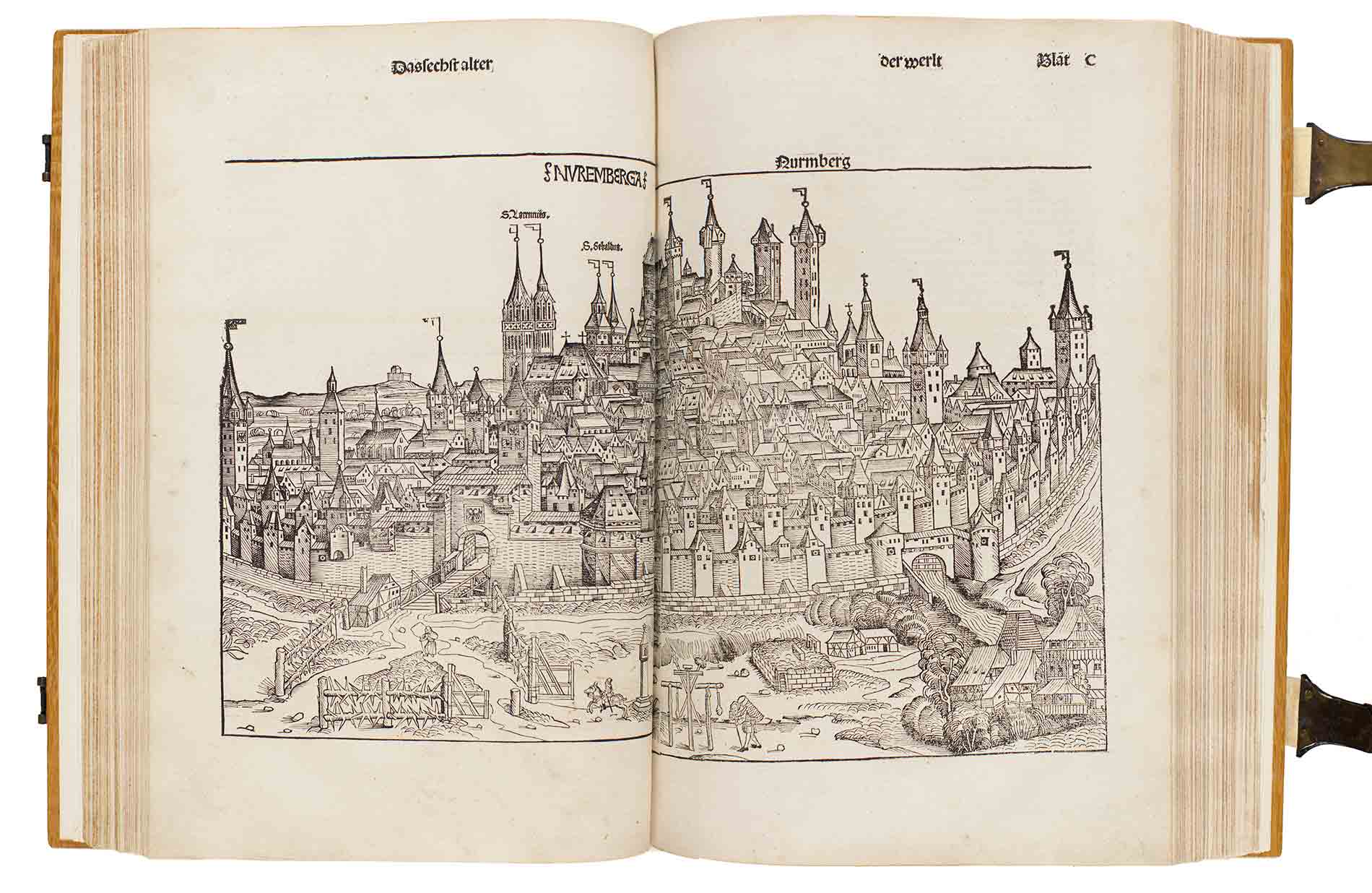
Renaissance Nuremberg (Nürnberg), the neighboring imperial city and artistic rival of Augsburg, was a lively commercial center in southern Germany whose intellectual life centered upon an impressive circle of humanist scholars, notably Albrecht Dürer’s (1471-1528) close friend Willibald Pirckheimer (1470-1530), Conrad Celtis (1459-1508) and Hartmann Schedel (1440-1514), author of the Nuremberg Chronicle. As an environment in which to live and work it must have inspired painters, printmakers, and sculptors through the powerful presence of its splendid houses and churches, and especially its medieval towers, fortifications, walls and castles. Such structures appear not only in Renaissance depictions of Nuremberg itself (Fig. 1) but also in the background of engravings by Dürer such as his St. Anthony of 1519 (Fig. 2). In the foreground sits the hermit saint who withstood all worldly and satanic temptations, enveloped in voluminous drapery that forms a solid pyramidal shape, reiterated by that of the cityscape behind him. The hill with its clustered structures can thus be interpreted as a metaphor for his spirituality, recalling Christ’s words from the Sermon on the Mount: “You are the light of the world. A city on a hill cannot be hid” (Matthew 5:14). 1
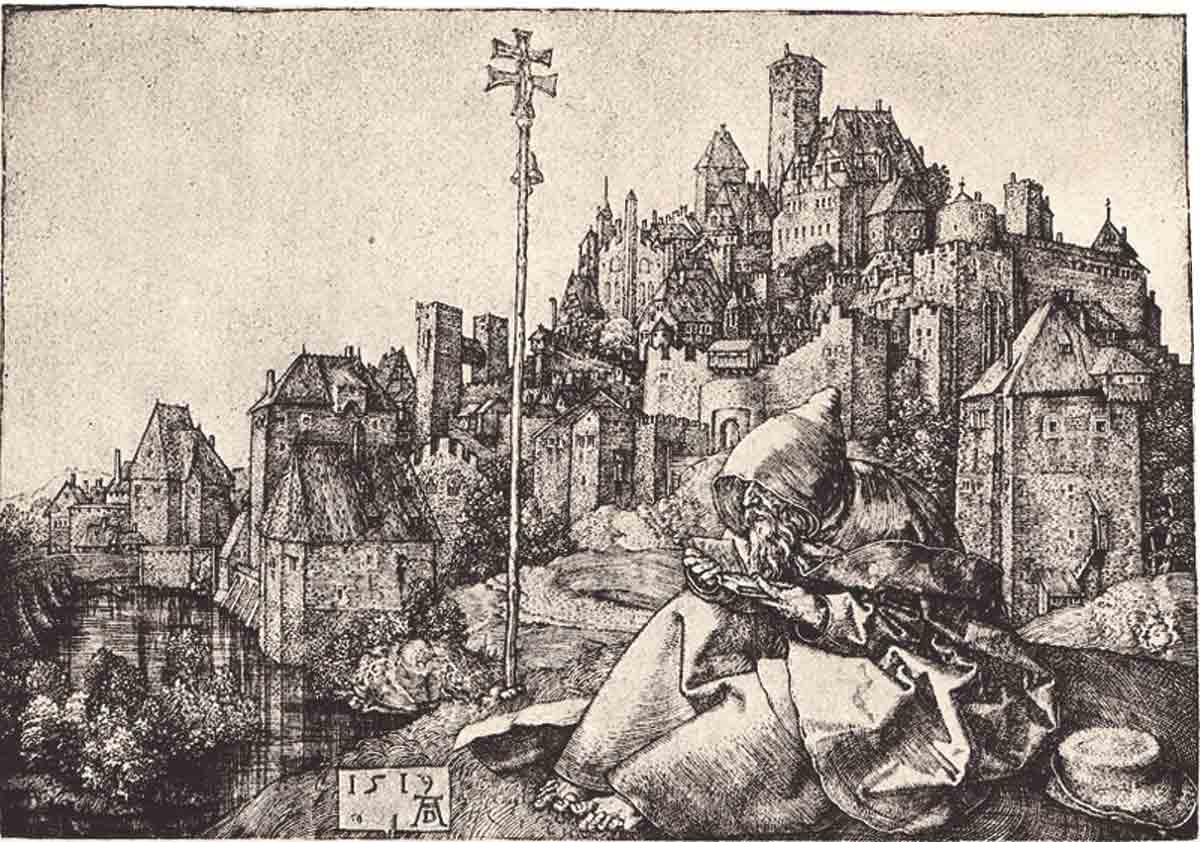
A prosperous commercial center, Nuremberg offered substantial patronage to its many artists and craftsmen, along with a stimulating flow of ideas and images within and beyond a city whose ties to the larger world were facilitated by major trade routes which converged in its vicinity.2 Thanks to nearby iron deposits, Nuremberg’s economy was largely based upon the mining and metalworking industries which produced suits of armor, weaponry, and precision measuring instruments for mapmaking, astronomy and mathematics. Moreover, the city became a major center for printing and publishing during the Renaissance, as the recently invented (c. 1450) printing presses used metal movable type.
Not surprisingly, portrait medals, a durable and easily circulated form of art which originated in ancient Rome and was revived in early fifteenth century Italy, became popular in both Augsburg and Nuremberg, along with painted and printed portraits. By the early sixteenth century their production greatly increased with the growing humanist emphasis on recording individuals’ appearances and accomplishments. For rulers, the issuing of portraits as minted coins or presentation medals (Schaumünzen) allowed them to spread their fame during their lifetimes, while leaving tangible records of themselves to posterity, including inscriptions and coats of arms. As Emperor Maximilian I declared, “The man who makes himself no memorial in life is forgotten with the tolling of his death bell.”3 Those who had the resources but no authority to issue coinage could commission such likenesses themselves from sculptors, founders or metalsmiths, usually profiles to emulate antique coins. Since medals were cast and circulated in multiples, one’s name and likeness could be distributed as in less expensive, more widely disseminated prints on paper.
Among the German metalworkers active in the Renaissance the goldsmiths, of course, used the most costly and esthetically refined materials to create their glittering portrait medals, elaborately worked small sculptures, precious decorative objects, fine tableware and jewelry. But the importance of goldsmiths during this period would surpass even their own creations of beautiful objects. Many of the most gifted German draftsmen and printmakers, such as Master E.S. (c. 1429-c.1468), Martin Schongauer (c. 1440-1491), and Albrecht Dürer drew their first lines and learned the process of engraving in the workshops of fathers and or teachers who were goldsmiths. Furthermore, both Johann Gutenberg (c. 1395-1468), the inventor of the printing press, and Dürer’s godfather Anton Koberger (c. 1440/45 – 1513), the leading German publisher and printer who issued the Nuremberg Chronicle, began their careers as goldsmiths.
In the sixteenth century the great Nuremberg goldsmith Wenzel Jamnitzer (1507/08 – 1585), was considered second in art only to his close Florentine contemporary Benvenuto Cellini (1500-1571).4 An etching by Jost Amman (1539-1591), which shows Jamnitzer at work in his studio (Fig. 3), reveals the geometric precision he brought to his design process and the tools he developed to do so. The print is a telling document of its time because it omits nearly all indications of manual and material labor to present Jamnitzer as the man of intellect and creative invention who wrote Perspectiva Corporum Regularium (Perspective of the Regular Solids) in 1568 as an exposition of how the five geometric solids, discussed in Plato’s Timaeusand Euclid’s Elements, could be brought into correct perspective for the first time and used to construct other geometric bodies of endlessly varied shapes.5
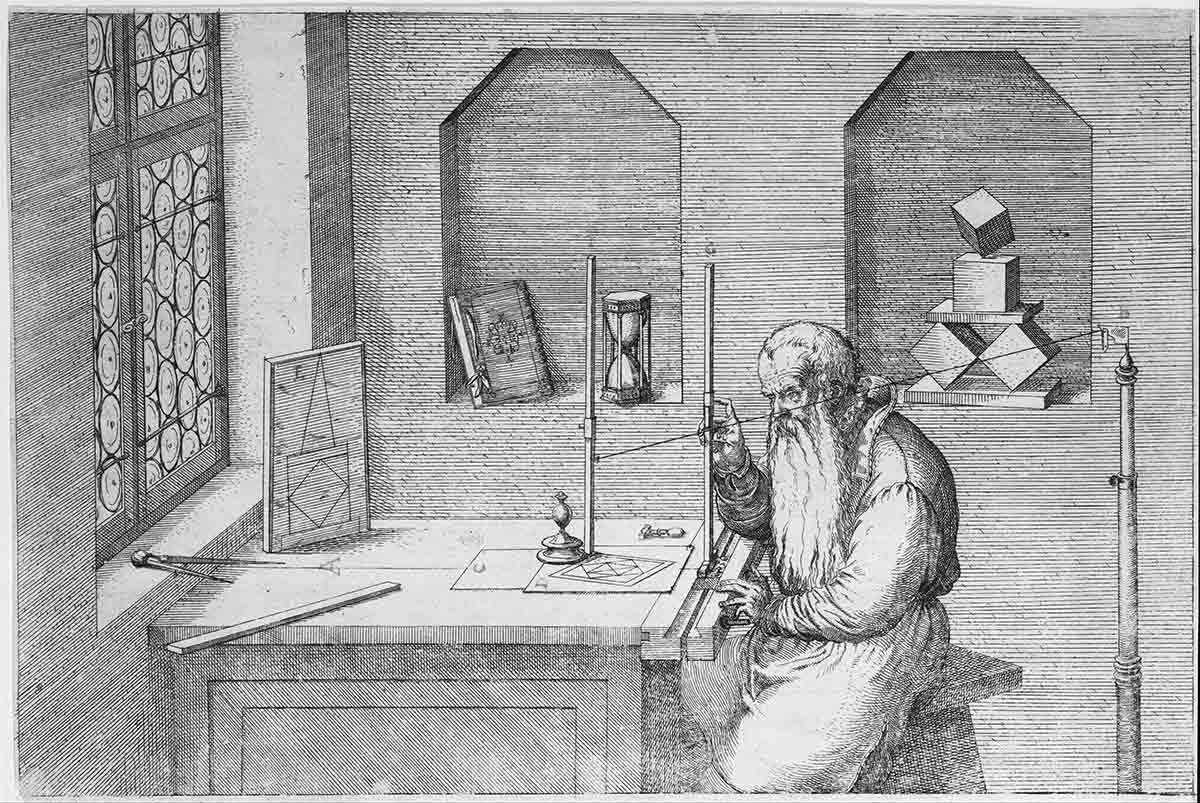
Even more than artists in Renaissance Italy, where major treatises on art were written by Leon Battista Alberti (1401-1472) and Leonardo da Vinci (1452-1519) among others, German artists of this period were troubled by issues of professional status and prestige. Jamnitzer’s unusual range of combined activities as a fine craftsman, sculptor and theoretical thinker parallels that of Albrecht Dürer, the most internationally celebrated Nuremberg painter and printmaker, who also composed treatises on proportion, perspective, and geometry. Both sought to teach basic, universal principles to art students and to raise the level of artists from their medieval classification as craftsmen to that of creators able to combine practical skill with theoretical knowledge. Erwin Panofsky has pointed out that the German word “Kunst” (art) originally had different definitions expressed by similar-sounding but different verbs: the first (können), referring to the ability to project objects or effects the way nature produces stones, butterflies or thunderstorms, and the second (kennen), referring to activities involving theoretical knowledge rather than practice—a meaning only in use today in reference to the Liberal Arts.6
As Jeffrey Chipps Smith has outlined, the history of Renaissance art in Nuremberg was marked by an important transition, around 1500, from regional to international status and from medieval to early modern attitudes toward the making and meaning of images.7 That shift was stimulated both by the international circulation of prints and by Albrecht Dürer’s two visits to Italy (1494-95 and 1505-07). While retaining aspects of the traditional empirical naturalism of northern European art, prints by Dürer and his followers introduced new Italian ideas about the representation of figures and space. This transition can be seen in the blend of late Gothic detail and Renaissance idealism in the sculptures of Veit Stoss (before 1450 – c. 1533, active in both Nuremberg and Cracow) and in engravings by Dürer such as hisNemesis (“The Large Fortune”)of c. 1501 (Fig. 4). An allegorical personification of the classical goddess of Fortuna, this muscular female is elevated precariously upon a small globe far above a vast, naturalistically detailed landscape of mountains and villages. Seen in profile, the figure displays a daring attempt to fuse two fundamentally irreconcilable approaches to depicting the human body: an idealizing Vitruvian canon of harmonious mathematical proportions, combined with direct observation of an actual human model with her heavy thighs, protruding abdomen and double chin.8
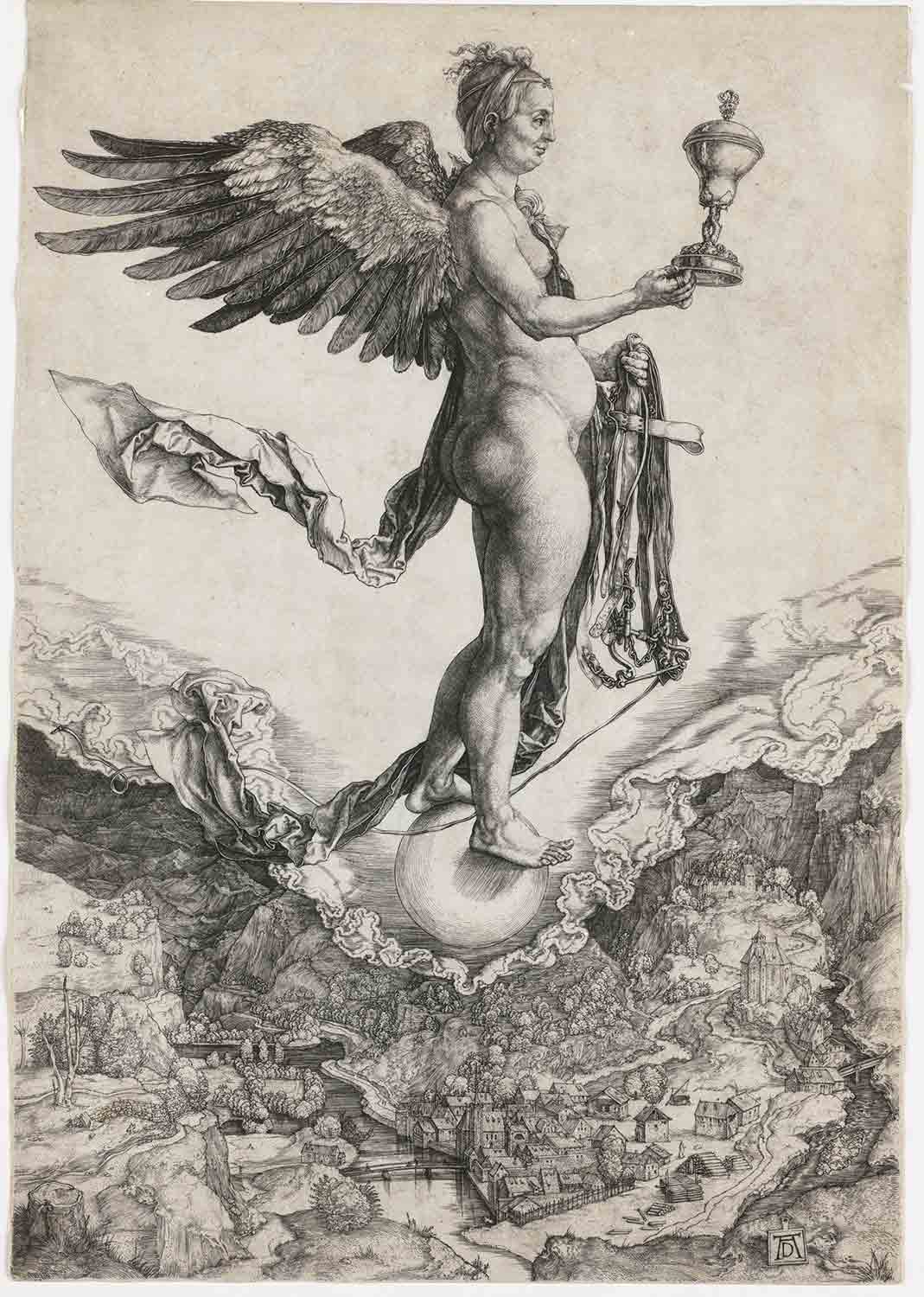
At the date (1492-93) of the Latin and German publications of the Nuremberg Chronicle, however, these developments lay just ahead. The leading artist in the city was then the long-lived and extremely influential painter and printmaker Michael Wolgemut (1434-1519), who had married the widow of his master, Hans Pleydenwurff (c. 1420-1472), taking over that active workshop in 1472. Wolgemut, with whom Dürer apprenticed between 1486 and 1489, soon became the leader among Nuremberg artists striving to elevate the standard of woodcut illustrations used by Nuremberg’s publishing firms, including that of Anton Koberger, the publisher of the Nuremberg Chronicle.
With his stepson Wilhelm Pleydenwurff, Wolgemut was commissioned to illustrate Hartmann Schedel’s text in 1487-88, with a final contract of December 29, 1491, for designing the layout of both text and illustrations. A total of 652 woodblocks produced prints of famous men and cities of the world along with stories encompassing seven ages of history from the Creation to the year 1493. Koberger advertised his book by promising readers an entirely new experience: “…so great a delight in reading it that you will think you are not reading a series of stories, but looking at them with your own eyes.”9 His lively choice of words signals an enormously enhanced role of the image (versus text alone or text with limited illustration) following the invention of the printing press. More and more, images would be used to report and interpret ideas and information, tell stories, and express issues of their time. At the same time, an increasing focus on printed images meant new responsibilities for those who created them: to formulate ever clearer and stronger visual language through line to engage and inspire the viewer.
Wolgemut’s and Pleydenwurff’s celebrated double-page woodcut of Nuremberg (Fig. 1), the earliest published view of the city, performs that mission by assembling a powerful visual message about its prosperity, security, piety and political importance as an imperial free city.10 Seen from outside its fortified walls with their tall watchtowers, as if by the approaching travelers at the center foreground, the city appears as a densely constructed mountain of walls, windows and peaked rooftops which rise triumphantly to even loftier silhouetted spires at the top. Below the title (NVREMBERGA) are the only two structures specifically named: the churches honoring St. Lorenz and St. Sebaldus, the city’s two patron saints. With or without added coloring, illustrations in the Nuremberg Chronicle display the advantages of woodcut which can yield hundreds of strong impressions whose crisp linearity creates boldly expressive shapes with easily readable detail.11 Book illustrations in woodcut also tend to produce the most coherently unified combinations of words with pictures since the graphic effect of a carpet of text which reads on the surface of the page is enhanced—but not undermined—by images whose distinct lines simultaneously affirm surface and imply illusions of depth. On such pages text and image can come to life together in complex narratives like the Chronicle’s Temptation and Expulsion of Adam and Eve (Fig. 5), which is filled with selective but richly varied details such as the palm and fruit trees of Eden contrasted with the bare stony realm into which the first couple, no longer immortal, have been banished. Between Paradise and the World the angel wields a sharp sword with one hand but places a softly consoling hand on Eve’s shoulder with the other.
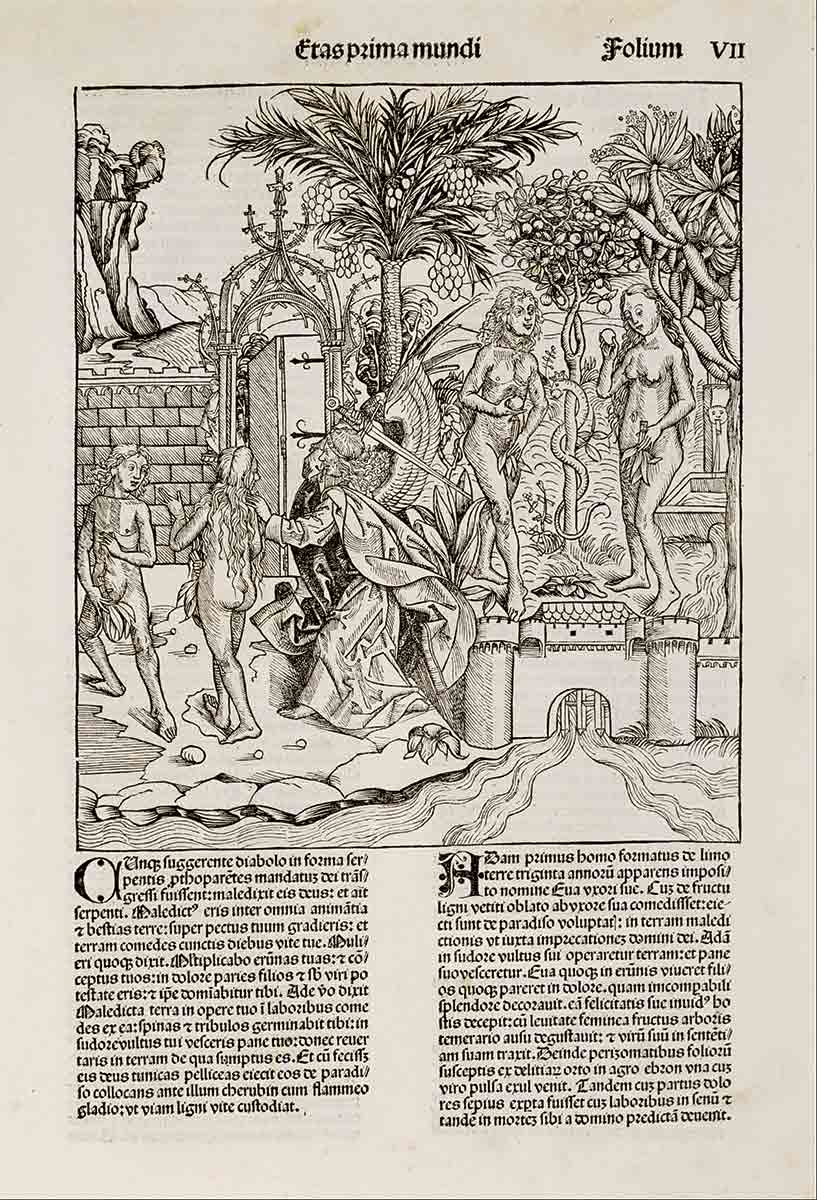
Wolgemut and Pleydenwurff ingeniously adjusted the medium of woodcut to suit diverse themes represented in the Chronicle.12 Thus, line becomes more abstractly summarizing to express the nightmarish Dance of Death (Fig. 6), an originally late medieval theme in northern Europe relating to fears of pestilence, war and famine. In this well known example we confront the universal consequence of Adam and Eve’s Fall in two grinning, marionette-like skeletons, framed by decaying corpses: one piping musical accompaniment, another (consumed by worms), emerging from an open grave, and a third leading the dancers as if to remind them to resist the inevitable until the very end.
As noted earlier, the period following the publication of the Nuremberg Chronicle, which saw the flowering of Albrecht Dürer’s influential career, brought to German artists a new awareness of Renaissance developments in Italy, specifically the revival of ancient themes and idealizing styles from a classical past that had been largely foreign to northern Europe. The so-called Kleinmeister (small masters) of Nuremberg, named for the miniature scale of their finely detailed engravings, display all the complexities of this period.13 Indeed, their works reflect a blend of the lively empiricism of northern art combined with allusions to stable traditions of the classical past. At the same time they responded to the highly volatile atmosphere of the Protestant Reformation whose beginning has traditionally been dated to 1517. In that year Martin Luther nailed to the door of the Castle Church in Wittenberg hisDisputation on the Power and Efficacy of Indulgences (the “ninety-five theses”), provoking a firestorm of protest against rituals and practices of the Catholic church, above all that of image worship.
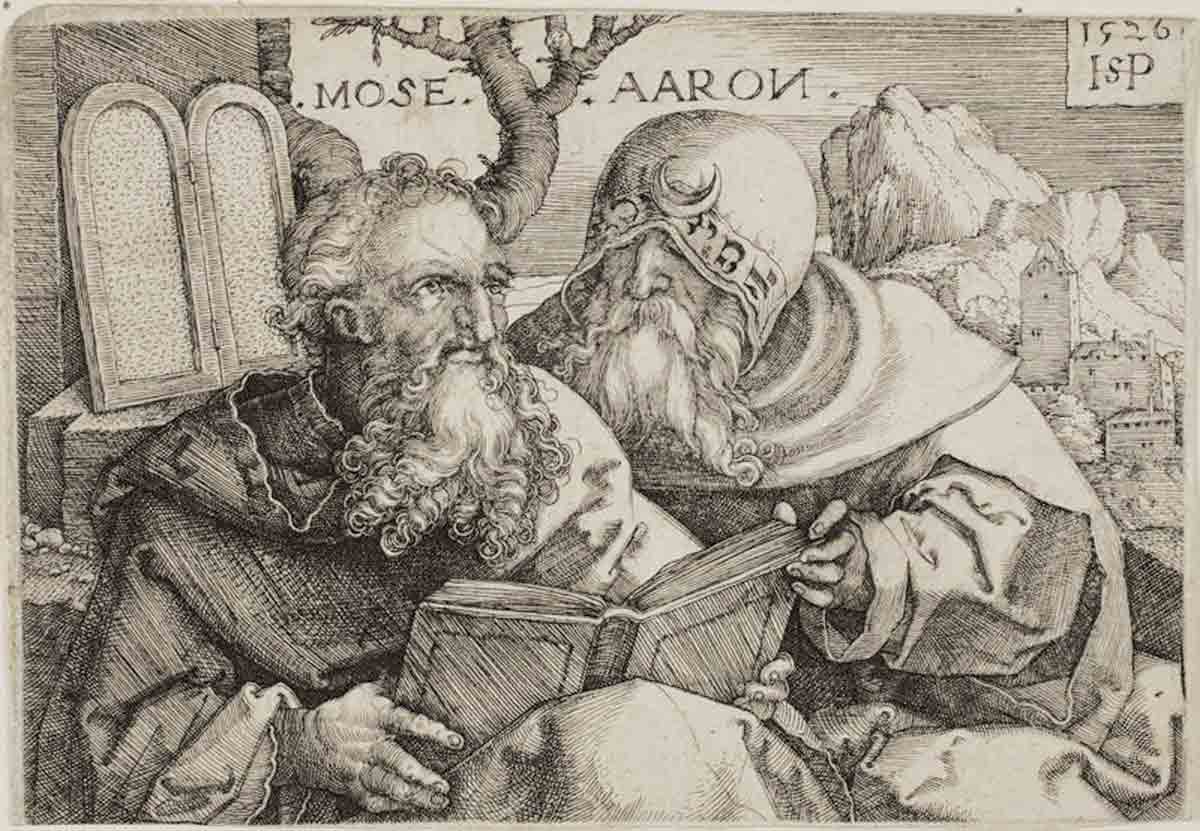
A powerful deterrent to the production of devotional art, the Reformation summoned Christians to turn directly to their own reading of the Word of God in the Bible, prompting the creation of images in which texts, books, words and letters often receive special focus. Hans Sebald Beham’s (1500-1550) tiny Moses and Aaron (Fig. 7), dated 1526, for example, shows the two venerable sages, seemingly transported into the present since their mountainous background features a German town. Named by inscriptions (as is the artist), the two men consult over a codex, the kind of bound book with pages which would only come into use many centuries after these Old Testament brothers led the Israelites to the Promised Land. This scene must have resonated with Reformation viewers who supported the challenge to Catholic ritual of the new Protestant emphasis on direct revelation through the Word. In the print, clear-sighted Moses— strikingly Michelangelesque—suggests Revelation, while blind Aaron, wrapped in his prayer shawl, evokes Ritual, a dichotomy further implied in the revelatory tablets of the Law at the left versus the codex, which may represent the traditional textual corpus of the rabbis.14 In Beham’s print the two empty tablets of the Law apparently await the earliest publication of the Judeo-Christian world: God’s transmission of the Ten Commandments. That the tablets behind Moses parallel the modern codex that he holds in his hands may even suggest a witty visual comment on the long history of printed communication.
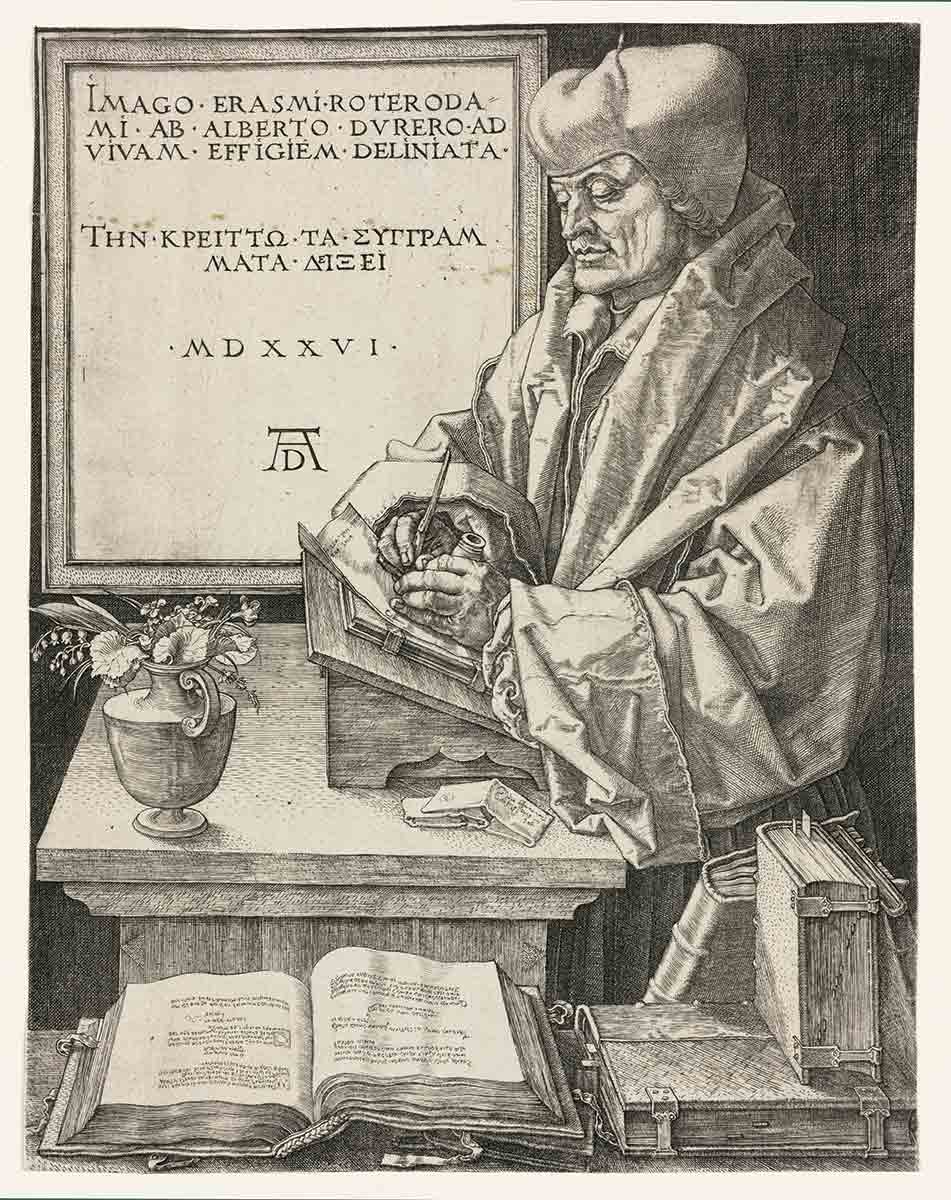
In the same year, 1526, Albrecht Dürer, formulated his own reflection on the power of words in his final engraving: a large Portrait of Erasmus (Fig. 8), the great humanist scholar of Rotterdam who stands at his writing desk, pen and inkwell in hand, in the midst of his work. The only allusion to nature in this study room is the graceful antique vase on the desk before him which contains delicate, fragrant violets and lilies of the valley. All else is print and more print: in the volumes laid out in the immediate foreground—opened, closed and placed at different angles as if to demonstrate what a book is—and especially in the large framed plaque facing the viewer above the desk. There, Roman- style letters in Latin identify sitter and artist and state that the portrait was made from life, followed by a declaration in Greek that one can best know Erasmus through his writings. Indeed, by shifting Erasmus toward the right Dürer makes the window-like plaque, which even seems to admit light, the main focus of the scene, indicting the precedence of word over image in expressing the real “portrait” of this sitter.15
As the exceptional quality of the images reproduced here illustrates, the flood of new printed publications in this period, not only conveyed verbal and visual information to a larger audience than any previous one in history but also stimulated artistic creativity to new levels. The art of Renaissance Nuremberg expresses refined and sophisticated technical virtuosity, combined with artists’ thoughtful responses to the major debates and issues of their time.16
Notes
1 Dorothy Limouze, The Felix M. Warburg Print Collection; a Legacy of Discernment, the Frances Lehman Loeb Art Center, Vassar College, Poughkeepsie NY, 1995, 29. See also Clifton Olds, “Durer and Nuremberg, “ in Robert A. Yassin ed., Durer’s Cities: Nuremberg and Venice, Ann Arbor, 1971, 9-15.
2 For discussion of the art, architecture, and crafts created in Nuremberg between 1300 and 1550 see the catalogue of the large exhibition at the Metropolitan Museum in New York and the Germanisches Nationalmuseum in Nuremberg (Gothic and Renaissance Art in Nuremberg 1300-1550, Prestal Verlag, Munich, 1986) includes individual essays on sculpture, brass work, panel painting, stained glass, printmaking, armor, and portrait medals.
3 Hermann Maué, “The Development of Renaissance Portrait Medals in Germany,” in Gothic and Renaissance Art in Nuremberg 1300-1500, 1986, 105-07.
4 On Jamnitzer, see P. Bernhard Demel et. al., Wenzel Jamnitzer und die Nürnberger Goldschmiedekunst 1500-1700, Germanischen Nationalmuseum, Nuremberg, 1985, and Erick Mulzer, “ Das Jamnitzerhaus in Nürnberg und der Goldschmied Wenzel Jamnitzer,”Mitteilungen des Vereins für Geschichte der Städt Nürnberg, 61, 1974, 48-373. (available online).
5 The five regular solids, also known as the Platonic Solids, are the tetrahedron (four faces), cube or hexahedron (six faces), octahedron (eight faces), dodecahedron (twelve faces) and the icosahedron (twenty faces).
6 Erwin Panofsky, “Dürer as a Theorist of Art,” chapter VII in The Life and Art of Albrecht Dürer Princeton, 1955, 242-247.
7 Jeffrey Chipps Smith, Nuremberg. A Renaissance City 1500-1618, University of Texas Press, Austin, 1983, 3-5.
8 As Dorothy Limouze rightly observed, this body type with its high waist and prominent abdomen can also be traced to late medieval art. Limouze 1995, 80-81. An example is the late-fourteenth century French “Warburg” Madonna in the Frances Lehman Loeb Art Center, Vassar College.
9 Chipps Smith 1983, 94. A number of the woodblocks were used more than once as discussed in Ronald Patkus’s essay.
10 Jeffrey Chipps Smith, in “Nuremberg and the Topographies of Expectation” in the onlineJournal of the Northern Renaissance (1:2009) identifies such significant details as the imperial double-headed eagle over one of the main gates to the city and the three crosses and stone crucifixion monument at the center foreground which indicate Nuremberg’s guardianship of the imperial relics of the Lance and a piece of the True Cross.http://www.northernrenaissance.org/nuremberg-and-the-topographies-of-expectation/
11 Neither the contracts nor the examplars for the Nuremberg Chronicle mention coloring the woodcuts, but the final 1509 assessment of the book’s profits and losses states that Koberger distributed both uncolored and colored copies of the book, the latter twice as expensive as the former. Susan Dackerman, Painted Prints.The Revelation of Color, The Pennsylvania State University Press, University Park, 2002, 102-104.
12 The individual authorship of the hundreds of images in the Chronicle (which may perhaps include some participation of the young Dürer) remains unclear and is still debated by scholars.
13 Artists within this important circle of Nuremberg printmakers include Hans Sebald Beham and his brother Barthel Beham, Georg Pencz, Heinrich Aldegrever, and Albrecht Altdorfer. The Beham brothers and Pencz were all personally marked by Reformation turmoil as all were called to a board of inquiry in Nuremberg in 1525 for expressing radical religious views and were expelled from the city until Lutheranism was accepted by the city fathers several months later. Only Pencz would return permanently to Nuremberg. Cf. Stephen H. Goddard.The World in Miniature, Engravings by the German Little Masters 1500-1550, Spencer Museum of Art, University of Kansas, Lawrence, 1988, 15-16.
14 For this interpretation of the print I am indebted to Professor Marc Epstein, Vassar College (e-mail communication, June 10, 2014) who also observed that Moses‘s head is framed by a living, growing tree, while Aaron’s is juxtaposed with inert rock. He sees the Dianic moon on Aaron’s head as a symbol of both the Divine and the Be-Nighted and suggests that the partially legible Hebraic inscription on the crown of his prayer shawl may spell out EMET (truth).
15 Rainer Schoch in Gothic and Renaissance Art in Nuremberg 1300-1550, 1986, 337. On the significance of Dürer’s deliberate emphasis on letters in this engraving, and the impersonal effect of the portrait itself, see A. Hayum, “Dürer’s Portrait of Erasmus and the Ars Typographorum,” Renaissance Quarterly, 38, no. 4, Winter,1985, 650-87.
16 For their helpful suggestions on the writing of this text, my thanks to Ronald Patkus and Patricia Phagan.